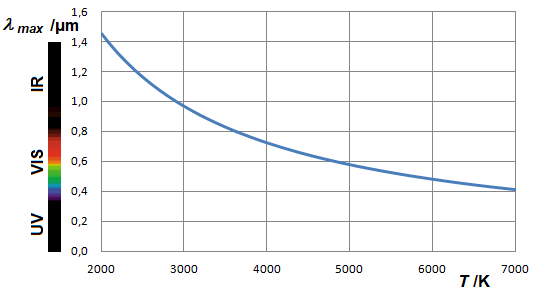2. Thermal radiation
The colour: Wien's displacement law
The area underneath the spectra of black bodies is of the same interest to us as the wavelengths of which the Planck spectra reach their highest value. This maximum seems to depend only on the temperature with a tendency towards smaller wavelengths at an increasing temperature. Regarding the Planck spectra as a frequency representation, one finds a tendency towards higher frequencies of the maxima at an increasing temperature. What functional dependency is this based on?
We start out from the frequency representation of the spectral energy density as we did for discussing the Stefan-Boltzmann law.
The search for the maximum of the radiation law is an extremum problem of mathematical analysis: deriving and zeroing the derivative. This is somewhat difficult because it is a transcendental equation: is found in first power and simultaneously as the exponent of the e-function. The detailed calculation can be found in the Supplement 2.4.
The result is:
The frequency of the radiation maximum of a black body increases proportionally with its temperature.
The position of the maximum as a function of the wavelength results from an analogous calculation, see Supplement 2.4. The result is:
In this case, we find an inverse proportionality: the maxima of the Planck graph as a function of wavelength follow a hyperbola.
This is called Wien's displacement law.
Source: Rainer Reuter, University of Oldenburg, Germany.
Knowing one value pair, the wavelength of the frequency of the maximum can be calculated for every other temperature through the rule of three. It is thus not necessary to memorise the value on the right of Wien's displacement law. It is sufficient, to know that:

